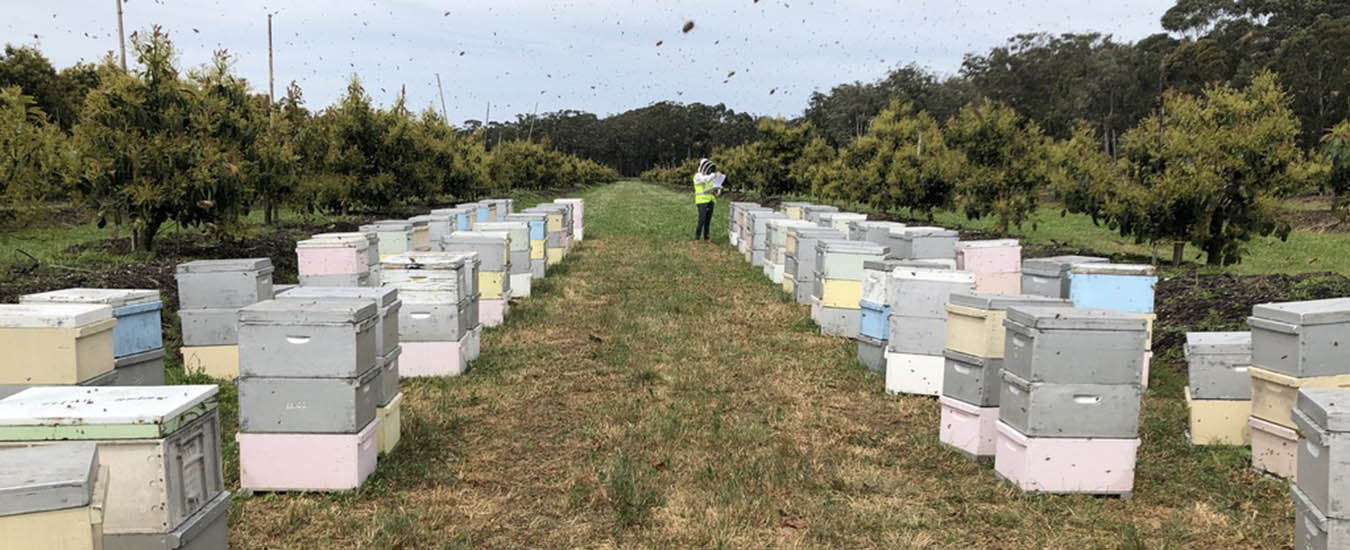As part of the Plan Bee program, research has been undertaken to determine the feasibility of breeding bees for specific crops.
Previous research has attempted to achieve this by selecting colonies that collected a greater proportion of pollen from the target crop (lucerne, apple, sunflower). Unfortunately, some of these programs resulted in stock with low brood viability and poor winter survival, and the stock was ultimately abandoned.
However, the mechanism used to select bees for avocado pollination was different. Avocados have protogynous dichogamy, meaning male and female flowers open at different times of day. Avocados are therefore best pollinated by nectar foragers, as they are more likely to move between flowers producing pollen and those producing nectar.
With this in mind, researchers selected for colonies with increased avocado nectar foraging. They did so by measuring the amount of a hydrocarbon unique to avocados, perseitol, in honey. High perseitol concentrations in the honey crop indicated that the colony had been foraging heavily on avocados.
There are drawbacks to selecting bee stock for a single crop. Crops are only available for a small portion of the year, and thus the bees need to be versatile to forage on a range of plants. Moreover, if the crop in question has any nutrient deficiencies, this will have an impact on the health of the hive and reduce its ability to perform pollination services.
Video: Male and female avocado flowers and hand pollination
Another strategy has been to select bees with a short foraging range. This will limit the ability of bees to fly to alternative forage surrounding the focal crop, and thus improve crop pollination. However, flight range is also influenced by the attractiveness of the crop and the alternate forage. Selecting bees with a smaller foraging range can have knock-on effects when colonies are not on pollination contracts. It could lead to over-stocking if there is a dearth of food nearby, which would cause reduced honey production, nutritional deficiencies within the colony and, potentially, to colony death.
As with humans, a varied diet improves bee health. Long-term foraging on a single floral source will result in poor health due to nutrient deficiencies. Selection of traits that benefit both beekeepers and growers is likely to lead to better outcomes for both parties. While growers may think that bees specially bred for their crops will help them gain a market edge, it is our responsibility as beekeepers to communicate the importance of colony health as a function of nutrition.
Strong, healthy colonies perform more foraging trips, and are therefore better for pollination and honey production. A focus on colony management and selection of traits that reduce disease and keep colonies strong and productive will help to ensure that our busy bees continue to provide the pollination services that help keep us all fed.
Acknowledgements:
- Plan Bee (National Honey Bee Genetic Improvement Program) is supported by funding from the Australian Government Department of Agriculture, Water and the Environment as part of its Rural Research and Development for Profit program. The project is further supported by AgriFutures Australia, the Department of Regional NSW, University of Sydney, University of New England Animal Genetics and Breeding Unit, Better Bees WA Inc, Wheen Bee Foundation, Costa Group, Olam, Beechworth Honey, Monson’s Honey and Pollination, South Pacific Seeds, Australian Queen Bee Breeders Association, Australian Honey Bee Industry Council, and commercial beekeepers.
- This article was peer-reviewed by Tom Gillard and Elizabeth Frost.


